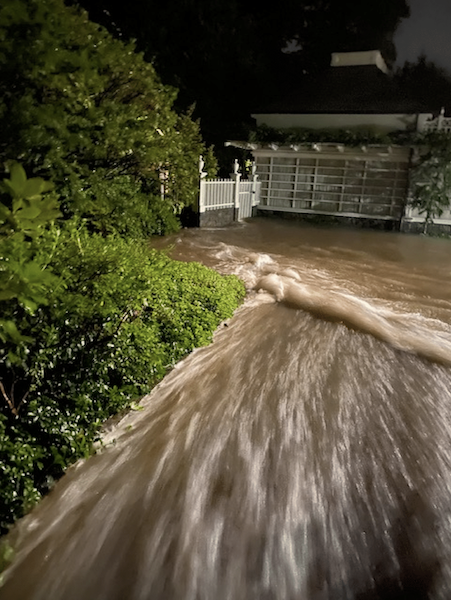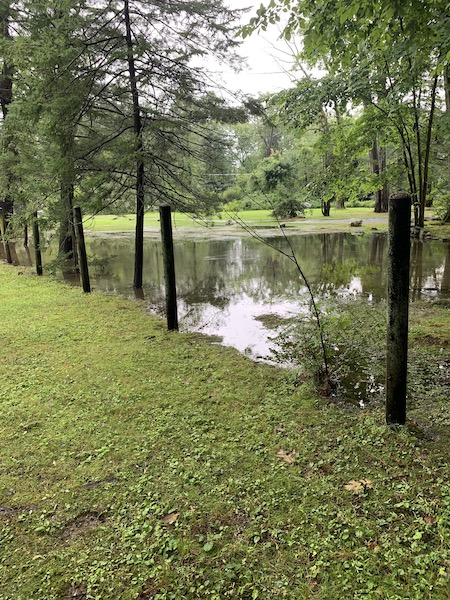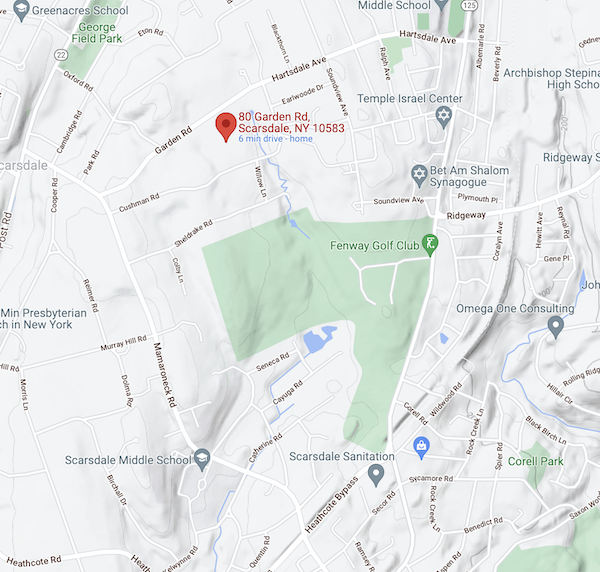Flooded Residents Tell Planning Board to Turn Down Garden Road Development
- Thursday, 23 September 2021 14:25
- Last Updated: Monday, 19 August 2024 08:40
- Published: Thursday, 23 September 2021 14:25
- Joanne Wallenstein
- Hits: 3442
 Driving rains and inadequate storm management systems caused catastrophic flooding in ScarsdaleThe timing of a developer’s appeal to build eight homes and a private road on a swampy lot at 80, 88 and 90 Garden Road could not have been worse. In the wake of Hurricane Ida, which deluged Scarsdale with an intense downfall of eight inches of rain, neighbors were already stressed and aggravated by flooding in their streets and their homes. The prospect of taking down over 300 trees and displacing even more pervious surfaces drew scores of residents to Village Hall on Wednesday night September 22 to voice their objections to the Planning Board as they heard the developer’s seventh attempt to win approval in 2021.
Driving rains and inadequate storm management systems caused catastrophic flooding in ScarsdaleThe timing of a developer’s appeal to build eight homes and a private road on a swampy lot at 80, 88 and 90 Garden Road could not have been worse. In the wake of Hurricane Ida, which deluged Scarsdale with an intense downfall of eight inches of rain, neighbors were already stressed and aggravated by flooding in their streets and their homes. The prospect of taking down over 300 trees and displacing even more pervious surfaces drew scores of residents to Village Hall on Wednesday night September 22 to voice their objections to the Planning Board as they heard the developer’s seventh attempt to win approval in 2021.
In response to questions from Mott MacDonald, an engineer retained by the Village to review the plan, the developer’s Attorney Lucia Chiocchio of Cuddy and Feder and his Engineer Eliot Senor presented their latest plans on how the property could retain more water than it generated and to explain where excess water would drain.
In their latest iteration, the builder is proposing to raise the grade of the seven acre site by four feet by hauling in truckloads of landfill and enclosing the site in a six foot retaining wall. Rather than pave the private road, they would use porous pavement over a 2-foot bed of gravel.
They claim that the current water table is four feet below ground and propose to install an underground detention system to collect the water in 36 inch pipe sections. Senor claimed that the landfill will absorb more water than the existing ground does now and that his conservative estimates showed that the development would decrease the overall run off to Cushman Road by about 5%.
The road and detention system would be maintained by a private homeowner’s association.
The developer supplied a tree analysis to show the effects of tree removal and replacement. He plans to remove 322 trees to build the development and to plant 438 replacement trees to absorb water and remove carbon dioxide from the atmosphere. As it will take decades for these trees to reach maturity, he provided a series of calculations showing how many gallons of water these trees could absorb and CO2 they could absorb at mid-maturity.
Senor said he walked the property after Ida and “did not see a lot of standing water, and the road was not muddy.” He said, “The stream did not exceed its banks.” He continued, “I saw the devastation on Cayuga Road but this will not add any water to that system – it will reduce it by 4% or 5% at total build out. We are providing for a 100% impervious surface.”
However after reviewing the report, MacDonald concluded, ‘In all, it appears that even if the assumptions and conceptual model that  Garden Road site following rains from Idaunderlie this analysis were appropriate for this site, the community would have to wait more than a decade for relief from the increased runoff caused by the replacement of 322 existing trees (plus about 70 invasive maple trees) with 438 small replacement trees.
Garden Road site following rains from Idaunderlie this analysis were appropriate for this site, the community would have to wait more than a decade for relief from the increased runoff caused by the replacement of 322 existing trees (plus about 70 invasive maple trees) with 438 small replacement trees.
About the water table MacDonald concluded, “The hydrologic analyses performed mostly focus on managing and reducing runoff but do little to address the impacts of the proposed work on the water table. In that the neighboring properties suffer from wet basements; it is not enough to target runoff alone. It may be that the combined proposed diversions from eight new private wells, without any return of wastewater to the aquifer, would be sufficient to assure the Board that the proposed subdivision would not cause a long-term water table rise or otherwise exacerbate the problem. But the proposed replacement of more mature trees with the proposed 3-inch DBH plantings will result in an increase in the amount of water that reaches the ground and a decrease in the amount of water taken up and transpired. Although there will be an increase in the proportion of impervious cover, the increased amount of water reaching pervious surfaces will increase groundwater recharge causing the water table to be higher than it might otherwise be.”
Planning Board Chair John Clapp said “In brief we are looking at a net increase of covered surface of 1.3 acres, an 18% increase in covered surfaces and the removal of 400 trees. The replacement trees will only absorb 13% of the water that is currently absorbed. He said, “the applicant will need to respond to Mott MacDonald’s memo before the project can move forward.”
Planning Board member Deb Pekarek asked for clarification on the site and was told, “The disturbance area is 5.2 acres and the total property is 7 acres which includes the house at 90 Garden Road. This was originally a 13 lot subdivision and 4 homes have already been built on Cushman Road. The original plan included a detention pond but there will no longer be a pond.”
Senor said “We have already removed some trees, brush and small saplings, but no trees about 6” DBH.”
Later at the meeting Village Engineer David Goessel said the developer had in fact removed 43 trees, 8 or which were larger trees that required a permit. He said a summons has been issued.
Another Planning Board member discussed the runoff. He said, “A 5% improvement is a very small improvement – this margin of error is not acceptable – it could in fact be worse.”
MacDonald said, “The area already floods. If you fill it in it could make the flooding higher. I asked for an off-site drainage analysis. We need 100 year storm analysis. We are trying to make sure that this does not exasperate an existing problem. There is only a one and half foot drainage pipe there now.”
 A topographic map shows water from the Sheldrake River draining from Garden Road, past Cushman and Sheldrake, to Fenway Golf Course and down to Cayuga Road.About the porous pavement, MacDonald said, “As the years progress it will get less effective. The pervious pavement deteriorates and needs to be maintained.”
A topographic map shows water from the Sheldrake River draining from Garden Road, past Cushman and Sheldrake, to Fenway Golf Course and down to Cayuga Road.About the porous pavement, MacDonald said, “As the years progress it will get less effective. The pervious pavement deteriorates and needs to be maintained.”
The public comments portion of the meeting extended well into the evening. Many read from letters they had sent to the Planning Board to object to the development and you can read the letters here:
A representative from Fenway Golf Club, which is downstream from Garden Road said that “five golf holes were impacted in the storm – a lake was created on the golf course…. Mr. Senor has to demonstrate that there will be no additional runoff.”
He continued, “Our consultant found no data for the claim of a 5% reduction. There is no analysis to show whether it’s right or it’s wrong –there is nothing to review. I am disappointed that this is on the agenda again without all the pieces. Why have they not mentioned the Sheldrake River Basin? That is why Scarsdale is flooded. They should not increase pressure to the neighbors.”
A team of lawyers and engineers from Zarin and Steinmetz representing Bob Falk of 3 Willow Lane said, the engineer’s “statements are unsubstantiated. There is incomplete information and deficient data. They have not produced an updated SWIPPP (a stormwater pollution prevention plan) as is required by the Planning Board. During Ida, water rushed down my client’s driveway. His first floor was wrecked during the storm.”
Greg Fleisher and Environmental Engineer said, “The current site has very poor drainage. In raising the grade you create a host of other problems. Where does the water go once it hits the water table? Where does the ditch around the property drain? There is a pond in the southeast corner that drains into one 18 inch pipe to Cushman Road. This will worsen conditions on Cushman Road – excess water will jeopardize those properties.”
Robert Rieffel of Cayuga Road said, “There is little infrastructure built to accommodate all this water. Our rights must be weighed against the rights of this developer. The existing infrastructure is already inadequate. Protect the rest of the Village, not the developer.”
Another Cayuga Road man said, “Our street was devastated. Cushman Road is 30 feet higher than Cayuga Road. Water goes downhill –it doesn’t make a difference how. Cayuga is the last built development. We have drainage from Catherine on the east and Cushman and Garden on the west. There is a serious issue…people losing their basement sand first floors repeatedly – this is a real, grave situation. There is an obligation to deal with people’s homes. I am 76 years old – you can’t go through this over and over. There are easy remedies for this water – please address it. This area is being devastated; infrastructure improvements are needed now.”
Andrew Rodman of Cushman Road said, “Is the grade being raised next to the water tower – it will all drain into my property? I will build a wall and drain into my neighbor’s yard– and if this proceeds Bobby Falk’s house will be washed away. There was a heck of a lot of water after the storm on Garden Road. It is sad what is going on – we have to save Scarsdale.”
Greg White from 44 Garden Road said, I have lived here for 30 years. I am a civil engineer. I am a new grandfather. Garden Road is the Indianapolis speedway in the morning and at night. If we have more cars and buses, it is going to be scary. I am frightened for the children in the area. The water table is so high that we don’t need sprinklers. The hydrostatic pressure in this area is extraordinary. The roadways will fail. The soil is dense clay so the water doesn’t go anywhere. Two weeks ago we lost two cars in the storm and our first floor library is also gone.”
Shari Beckman of 75 Garden Road said, “The current developer proposal for the site at 80 Garden Road is a nightmarish vision for all of the residents who live in our beautiful, but waterlogged, area. We have lived in our home, which had been newly developed at the time, on Garden Road for twenty years. The builder proudly showed us the sophisticated, synchronized multiple sump pump system he installed to allay fears on the part of potential buyers who knew that the home was built in a wetland area and quite literally sits on top of water.
Over the years we have been here, we have watched ponds of water appear on our back property from moderate rains. We have also suffered three separate incidents of serious flooding of our entire lower level; we have emergently drained, dried out, de-molded, gutted and rebuilt this space at tremendous cost, emotionally and financially. We live, by the way, on the opposite side of the road that is known to dangerously flood so often. It is clear to us that we and our neighbors live with the peril of endless water below. There is no way to change that.
But it is also clear that the deliberate removal of 5 acres of fully grown trees with substantial roots that have taken hold over the years would seriously deteriorate an already impossible situation. From every perspective, ecological and practical, this would be an extremely grave mistake. Furthermore, the proposed building of so many additional homes would deplete even more the existing shortage of our scarce resources, such as outdated phone and electrical wiring and insufficient water pressure.
With climate change issues upon us, when we expect more frequent and serious storms, this is not the time to be building new structures atop a deteriorated infrastructure. We all know that at Disneyworld, underneath the magic of the sights and sounds we enjoy with our grandchildren, is an entire secret city that services the wonder and awe we experience at such a special place. We consider it a privilege to live in Scarsdale, but shudder to think of what our village looks like underneath the charm and beauty of the homes that make up our community.”
Barry Abramson of 98 Garden Road has lived here for 23 years. He said, “I urge you to reject the applicants proposal. My backyard is adjacent to the project. One third of my yard has standing water after a rainfall. The three new houses on Cushman Road increased this from 25% to 33%.”
About the landfill he said, “About bringing in 1000 truckloads of fill … What is clean fill? Fill is not clean. It is not free of contaminants and pollutants like arsenic, asbestos, lead, and lead paint chips. There will be debris flying and we will be breathing it for years. The wall surrounding it will need weep holes and the fill will drip out of the wall and drain into my backyard.”
Bob Berg said, “This is one of the worst applications I have seen. The developer has chutzpah. This is a wetlands. The stormwater system can’t take the stormwaters that we already create. The whole idea is crazy. Cayuga Road should never have been developed – it should have been open space.To allow this to go forward would be a crime.”
At the end of the meeting the Planning Board again voted to hold over a decision on the application.







